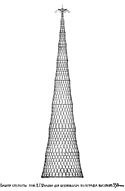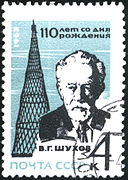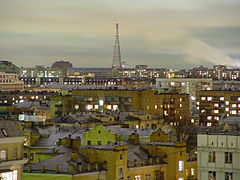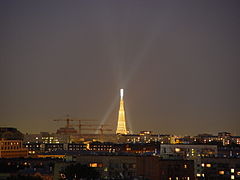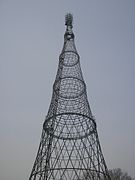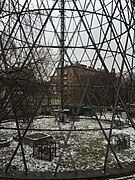Schuchow radio tower
|
Schuchow radio tower
Шуховская башня
|
|||||
|---|---|---|---|---|---|
| Basic data | |||||
| Place: | Donskoi in the Southern Administrative District | ||||
| City with subject status: | Moscow | ||||
| Country: | Russia | ||||
| Coordinates: 55 ° 43 ′ 2.6 ″ N , 37 ° 36 ′ 41.7 ″ E | |||||
| Use: | Telecommunications tower | ||||
| Accessibility: | Transmission tower not open to the public | ||||
| Tower data | |||||
| Construction time : | 1922 | ||||
| Operating time: | since 1922 | ||||
| Last renovation (tower) : | March 2016 | ||||
| Total height : | 150 m | ||||
| Data on the transmission system | |||||
| Last modification (antenna) : | Fall 2015 | ||||
| Waveband : | FM transmitter | ||||
| Send type: | Cellular | ||||
|
|||||
| Position map | |||||
|
|
|||||
The Schuchow radio tower ( Russian Шуховская башня ; transcription: Schuchowskaja Baschnja), also: Schabolowka radio tower , is a 150 meter high hyperbolic steel lattice tower in Moscow , which was built in 1922 as a transmission tower for the Soviet radio and, according to its designer, Shukhov (1853 - Vladimir 1939), was named.
history
After the October Revolution of 1917, Schuchow soon received one of his largest orders: the construction of a 350-meter high transmission tower for the Comintern radio station on Schabolowka Street in Moscow. In 1919 Schuchow submitted drafts and calculations for a tower that, despite being taller than the Eiffel Tower built in 1889, would have required only a quarter of the amount of steel. But since even these 2,200 tons were not available in Moscow at the time, Lenin finally signed an order in the summer to build a 150-meter-high version. The tower was a further development of the water towers and consisted of six hyperboloids placed one on top of the other . The bases of the individual floors were formed by rigid rings. This construction also enabled an amazingly simple construction process. Within the lowest part of the tower, the next segment was assembled on the ground and then pulled up with the help of five simple wooden cranes. The construction of the tower sparked great enthusiasm in the young state . Schuchow had made calculations that the entire Soviet Union could have been covered with three transmission towers of the originally planned height . However, the construction of a smaller tower remained.
The Krupp stamp is on half of the steel profiles used in the construction of the tower . The Schuchow radio tower is not open to the public. Today it serves as a cell phone mast. In 2014 it was planned to demolish the tower or at least relocate it to another location, allegedly due to damage to the structure, although the reason for these considerations was a lucrative rebuilding of the site. After international conservationists had sent a letter of protest to President Putin , the Moscow city parliament decided on July 16, 2014 not to dismantle the tower for the time being.
The antenna attachment installed in 1991 was removed in autumn 2015. As a result of this measure, the tower shrank from 160 to 150 meters. In March 2016, steel scaffolding was installed inside the tower to relieve the external walls. In January 2017, the Russian state broadcaster, as the owner, started planning a project to renovate the Shukhov radio tower.
See also
literature
- Klaus Bach, Murat Gappoev, Rainer Graefe, Ottmar Pertschi (eds.): Vladimir G. Šuchov 1853–1939 - The Art of Economical Construction. Deutsche Verlags-Anstalt, Stuttgart, 1990, ISBN 3-421-02984-9 .
- Elizabeth Cooper English: “Arkhitektura i mnimosti”: The origins of Soviet avant-garde rationalist architecture in the Russian mystical-philosophical and mathematical intellectual tradition. Dissertation, University of Pennsylvania, 2000 ( abstract , English)
- Daniel Engler: Vladimir Suchov. ( Memento from February 5, 2005 in the Internet Archive ) In: tec21. 41, 2004, pp. 9-13 (PDF; 509 kB).
- Christoph Rauhut, Ekaterina Nozhova: A threatened radio tower in Moscow. Symbol of the young Soviet Union. In: Neue Zürcher Zeitung . March 29, 2014
Web links
- Foundation Shukov Tower
- Schuchow radio tower. In: Structurae
- Dr. Rainer Graefe tells about Dr. Vladimir Shukhov. Video on Youtube.
- The Shukhov Tower is part of the World heritage. ( MS Word ; 588 kB)
- Schuchow and Gaudí ( Memento from August 1, 2013 in the Internet Archive ) (PDF; 887 kB)
- The Tower ( Memento from September 28, 2007 in the Internet Archive )
Individual evidence
- ↑ Christoph Rauhut and Ekaterina Nozhova: A threatened radio tower in Moscow: symbol of the young Soviet Union. Neue Zürcher Zeitung, March 29, 2014, accessed on April 18, 2014 .
- ↑ taz.de



